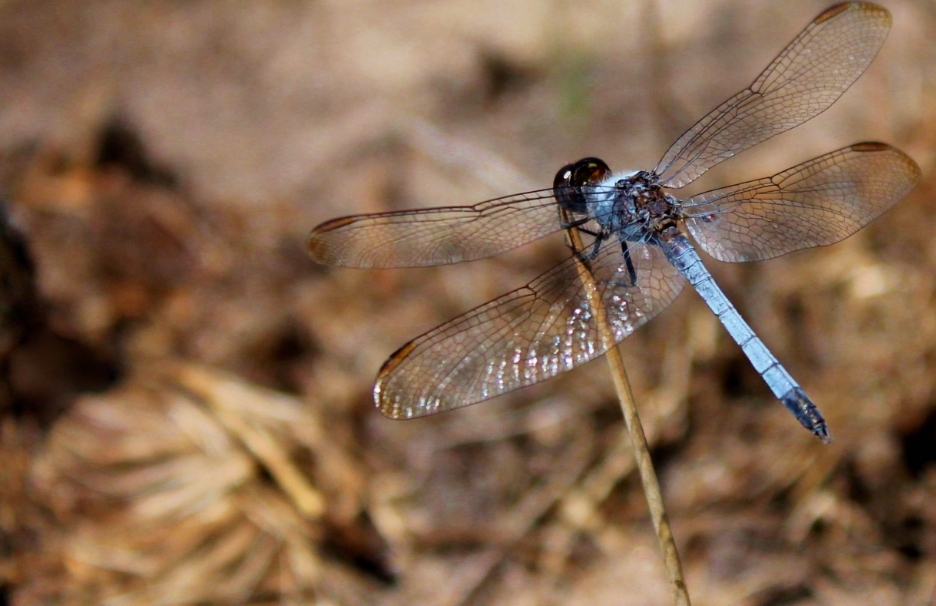

New species of dragonfly named Erythrodiplax ana has brown spots on its wingtips and a waxy body coating (photo: release)
New species of dragonfly named Erythrodiplax ana has brown spots on its wingtips and a waxy body coating.
New species of dragonfly named Erythrodiplax ana has brown spots on its wingtips and a waxy body coating.

New species of dragonfly named Erythrodiplax ana has brown spots on its wingtips and a waxy body coating (photo: release)
By Roberta Sales | Agência FAPESP – A new species of dragonfly with a brown spot on each of its four wingtips and a bluish waxy body coating has been described by Brazilian researchers in an article published in the scientific journal Zootaxa. Found in 2011 near a spring on the Itororó Ecological Reserve in Uberlândia, Minas Gerais State, Brazil, it has been named Erythrodiplax ana.
The new species was identified during the PhD research of Rhainer Guillermo Ferreira, that was supported by a scholarship from FAPESP during his postdoctoral research.
“The discovery is important above all because of the site where the species was found,” said Ferreira, first author of the article and assistant professor at the Federal University of São Carlos’s Center for Biological & Health Sciences (CCBS-UFSCar). “The nature reserve contains a vereda, a palm swamp wetland that provides part of Uberlândia’s water supply. The discovery of a new species in an urban area and with a habitat linked to a spring used to draw off water shows how little we know of Brazil’s biodiversity,” he told Agência FAPESP.
He added that dragonflies are natural predators of flies and important environmental indicators. “When you find these insects in the wild near a watercourse, it means the water’s good,” he said.
Between 2011 and 2014, the researchers compared the blue dragonfly’s morphology with those of 57 other species in the same genus. At the end of the period, they confirmed its status as a new species and began working on a description.
A combination of two traits distinguishes E. ana from other species in the genus. Particularly important is that the male’s body is covered with bluish wax. The female does not produce wax and is ochraceous (yellowish-orange). “Males of several species in this genus produce wax,” Ferreira said. “Some have wax only on their wings, which are bright blue.”
Another key trait of E. ana is the brown spot on each wingtip, which is rare in this genus.
Ferreira is investigating whether the wax serves as a kind of sunscreen to protect the male’s body from solar radiation since the insect is exposed to sunlight for many hours every day. Previous studies evaluated the properties of the wax found in other species and concluded that the blue coloring serves to reflect the sun’s ultraviolet rays, he noted.
The researchers believe E. ana is characteristic of wetlands in the Cerrado (savanna) biome. Besides the Uberlândia reserve, it was also found by the group in Chapada dos Guimarães National Park, Mato Grosso State.
In addition to Ferreira, the co-authors of the article are Ferreira’s PhD supervisor, Pitágoras C. Bispo, a researcher at São Paulo State University (UNESP) at Assis; Diogo S. Vilela, affiliated with the University of São Paulo (USP) at Ribeirão Preto; and Kleber Del-Claro, affiliated with the Federal University of Uberlândia (UFU).
The article “Erythrodiplax ana sp. nov. (Odonata: Libellulidae) from Brazilian palm swamps” can be retrieved from biotaxa.org/Zootaxa/article/view/zootaxa.4158.2.10.
Republish
The Agency FAPESP licenses news via Creative Commons (CC-BY-NC-ND) so that they can be republished free of charge and in a simple way by other digital or printed vehicles. Agência FAPESP must be credited as the source of the content being republished and the name of the reporter (if any) must be attributed. Using the HMTL button below allows compliance with these rules, detailed in Digital Republishing Policy FAPESP.





